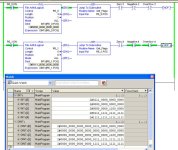RES on the CONTROL tag of a FAL performs exactly the same actions as "Enable-In False" condition.
All control bits are cleared, and the .POS value is reset to zero.
The choice of whether to use RES or XIO Control.DN boils down to whether you need the instruction to operate every time it is scanned.
Using XIO of the .DN bit to perform an instruction reset, means that the instruction will not operate again on that scan, but will have to wait until it is scanned once more to "Enable" it again. This means a FAL in "ALL" mode will only operate every alternate scan.
All control bits are cleared, and the .POS value is reset to zero.
The choice of whether to use RES or XIO Control.DN boils down to whether you need the instruction to operate every time it is scanned.
Using XIO of the .DN bit to perform an instruction reset, means that the instruction will not operate again on that scan, but will have to wait until it is scanned once more to "Enable" it again. This means a FAL in "ALL" mode will only operate every alternate scan.
Last edited:




